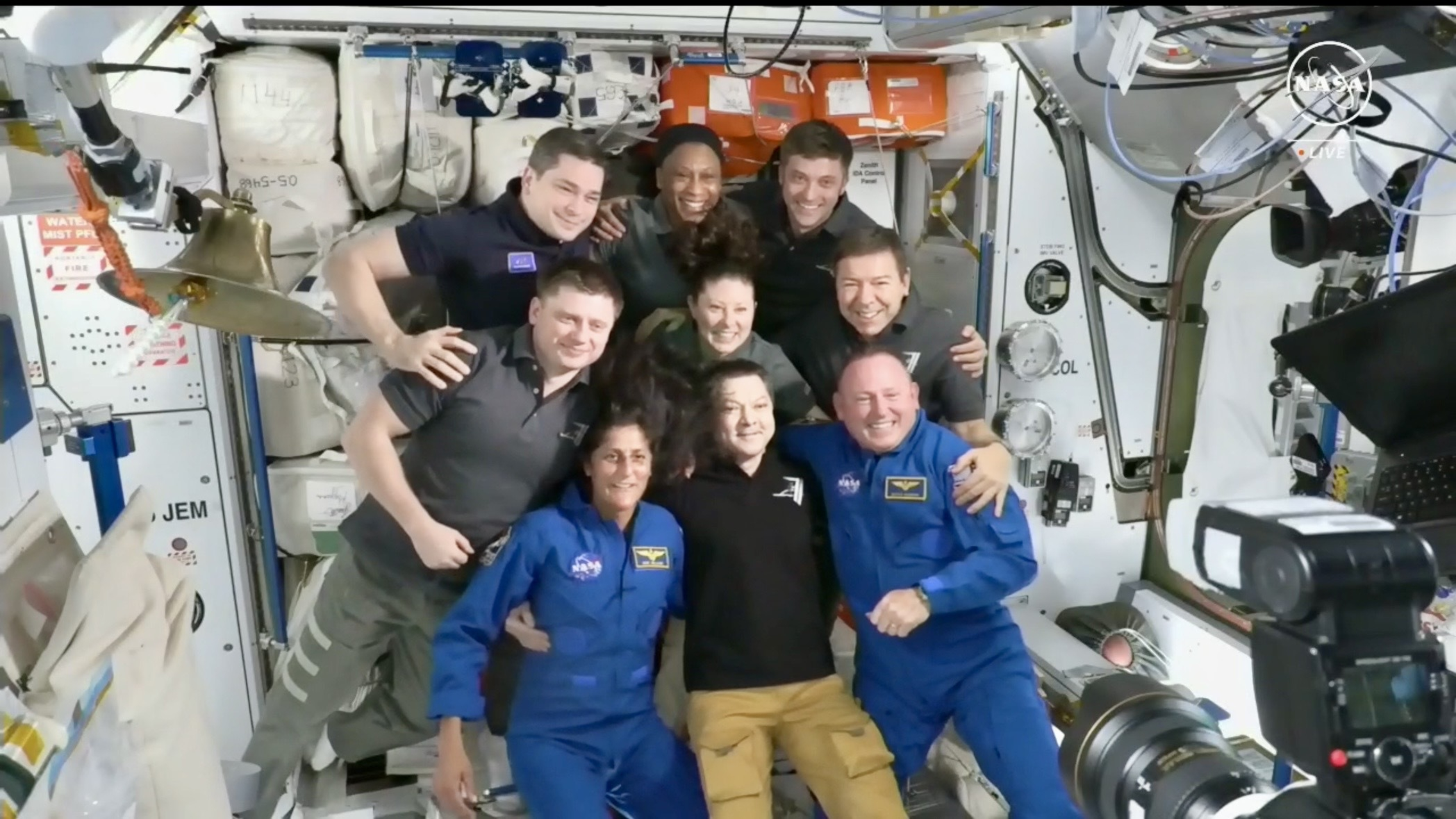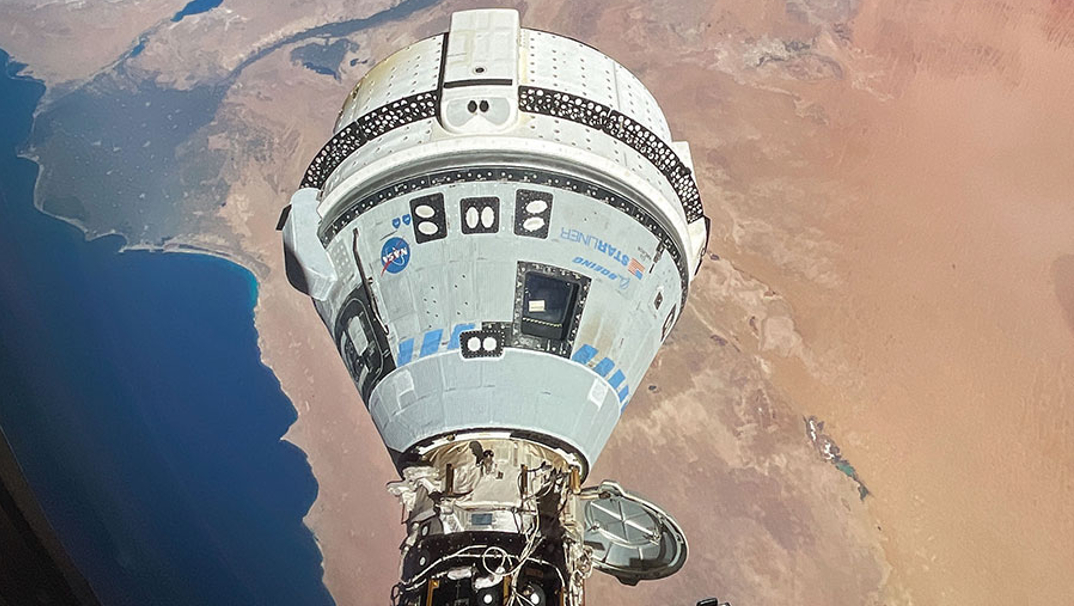When will Starliner come home? Boeing and NASA still don't know
Engineers continue analyzing several issues that have cropped up during Starliner's first-ever astronaut flight.

The first crewed mission of Boeing's Starliner capsule has been in orbit for more than a month now, and it still doesn't have a return date.
Starliner launched June 5 on Crew Flight Test (CFT), carrying NASA astronauts Butch Wilmore and Suni Williams to the International Space Station (ISS) for a planned week-long stay. The capsule experienced helium leaks and thruster problems during the trip, however, and engineers are still looking into what caused them — which means Starliner hasn't been cleared for departure yet.
"We're taking our time on the ground to go through all the data before we decide on the return opportunity," Steve Stich, manager of NASA's Commercial Crew Program, said during a press conference on Wednesday (July 10).
NASA, Boeing and the two CFT astronauts still have confidence in Starliner, however. During a separate media event on Wednesday, for example, Wilmore praised the capsule's on-orbit capabilities during operational checks. "The spacecraft performed unbelievably well," he said.
Wilmore also discussed the issues with Starliner's reaction control system (RCS) thrusters during its chasedown of the ISS, and how the mission dealt with them.
"We lost an RCS jet, and then another one, and then you could tell the thrust, the control, the capability, was degraded," he explained. "Thankfully, we had practiced, and we had gotten certified for manual control, and so we took over manual control for over an hour."
Related: Boeing's Starliner can stay in space beyond 45-day limit, NASA says
Get the Space.com Newsletter
Breaking space news, the latest updates on rocket launches, skywatching events and more!
After arriving at the ISS on June 6, Wilmore and Williams integrated into the station’s Expedition 71 crew, which, according to Williams, is now unofficially being called "Expedition 71+." Wilmore and Williams have taken on daily maintenance responsibilities and science experiments, and they've been able to close the gap on a handful of backlogged station tasks. Throughout their mission, the duo have also continued their checkouts of Starliner’s many systems and the anomalies they have encountered, which are also being scrutinized by Boeing engineers back on Earth to determine their cause.
Stich emphasized the meticulous approach taken to analyze data and replicate the spacecraft's thruster issues during testing at NASA's White Sands Test Facility in New Mexico. One advantage of the ISS, he said, is its ability to serve as a temporary orbital "hangar," providing a unique opportunity to understand Starliner's long-term performance in space before undocking.
In addition to the thruster issues, several helium leaks have been identified in the Starliner capsule. "There were a number of specific actions that were identified from both the helium and the thruster anomalies," Mark Nappi, Boeing’s vice president and Commercial Crew Program manager, said on Wednesday. "It's just a little bit over 30 [actions], of which more than half of them are closed at the moment."
"On the helium leak, we hope to bring that into the Starliner mission management team for final resolution later this week," Stich said. Despite these problems, agency officials said that the spacecraft is rated to leave the ISS in case of an emergency, with all but one of its 28 RCS thrusters cleared for use during reentry to Earth's atmosphere.
The decision to extend Starliner’s mission has also provided ground teams with additional time they weren’t expecting. According to Nappi, Amy Decker, of Starliner’s chief engineer's office, says the extra data they’re getting is "AWESOME, in all caps."
"The more time you have to get more data," Nappi said, "the more excited [the engineers get]."
Related: Starliner: Boeing's next-generation spaceship for astronauts

The absolute latest Starliner could return with Wilmore and Williams, according to Stich, would be mid-August.
"The big driver is the handover that we have coming up between Crew-8 and Crew-9, which is in mid-August," Stich said, referring to two SpaceX astronaut missions to the ISS. "So … a few days before that [Crew-9] launch opportunity, we would need to get Butch and Suni home on Starliner."
Ideally, though, they will come home sooner. "We're really working to try to follow the data and see when's the earliest that we could target for undock and landing," Stich said. "I think some of the data suggests, optimistically, maybe it's by the end of July, but we'll just follow the data each step at a time, and figure out when the right undock opportunity is."
"We do have a lot of confidence in the thrusters as they are today," Nappi said, mentioning an on-orbit thruster test fire that Starliner performed while docked at the ISS.
"What we're doing is just taking the time to make sure that we have looked under every rock and every stone, and just to make sure that there's nothing else that would surprise us," Stich added in response.
CFT follows two prior uncrewed Starliner missions to the ISS. The first, in December 2019, failed to reach the orbiting lab after experiencing a number of glitches. The second, in May 2022, successfully docked but also experienced thruster issues.
"We knew there'd be some learning from this flight test," said Nappi. "We've learned a great deal from how the hardware works, how our processes work, and how we can improve."
As of now, "there's one thruster that was producing very low thrust that we would disable for the rest of the flight," Stich explained. The extended stay at the ISS also helps teams get the spacecraft ready for future operational astronaut missions, which are planned to last up to six months, beginning with Starliner-1 sometime in 2025.
Tests at White Sands during CFT have helped planners look ahead to that first operational mission, and how to prevent similar thruster issues from cropping up.
According to Stich, Starliner’s thruster pulses were fired more frequently than engineers had expected this time around.
"What we're trying to do at White Sands," he said, "is really replicating exactly what those pulses were that the thrusters saw, and then understand the heating effects from those pulses, and just to make sure that there's no unintended consequences of those pulses."
Stich said he thinks there’s a way to take what the teams have observed with the thrusters during CFT to modify their requirements for future rendezvous and docking maneuvers. "I think that's the work in front of us for Starliner-1," he said.
As the CFT mission continues, the focus remains on ensuring a safe return for Wilmore and Williams. "Starliner is 'go' to return in an emergency," Stich confirmed. The team is working through the process, including a return flight readiness review, to prepare for Starliner’s eventual undocking and landing.
Join our Space Forums to keep talking space on the latest missions, night sky and more! And if you have a news tip, correction or comment, let us know at: community@space.com.

Josh Dinner is the Staff Writer for Spaceflight at Space.com. He is a writer and photographer with a passion for science and space exploration, and has been working the space beat since 2016. Josh has covered the evolution of NASA's commercial spaceflight partnerships and crewed missions from the Space Coast, as well as NASA science missions and more. He also enjoys building 1:144-scale model rockets and human-flown spacecraft. Find some of Josh's launch photography on Instagram and his website, and follow him on X, where he mostly posts in haiku.
-
newtons_laws I guess they'll have to borrow a few more spare clothes from their ISS colleagues..... ;)Reply -
Coconutwater I pray this ends well. It seems that NASA and Boeing are at their wits end on how to solve these problems. Let Elon Musk send a rescue craft and cut Starliner from the ISS.Reply -
FireNWater Unfortuately all that AWESOME data will end up getting dumped into the Indian Ocean . . . and Boeing will get a few million more taxpayer dollars to keep their engineers employed . . . . . <sigh>Reply -
Unclear Engineer I am wondering how much velocity change was required of the thrusters to reach the ISS, and how much will be required for the re-entry burns.Reply
Also wondering if any of he "thruster problems" experienced on the previous, robotic flight, occurred during the re-entry phase of the mission. -
jamestmallow Reply
Indeed. I hope Zeus returns them safely.Coconutwater said:I pray this ends well. It seems that NASA and Boeing are at their wits end on how to solve these problems. Let Elon Musk send a rescue craft and cut Starliner from the ISS. -
ruffleshaveridges Reply
Only way they're coming home safely is a ride from SpaceX, which is exactly what they're waiting for.Admin said:Boeing's Starliner capsule has been in orbit for more than a month, and it remains unclear when the spacecraft and its two astronauts will return to Earth.
When will Starliner come home? Boeing and NASA still don't know : Read more -
newtons_laws Reply
Seeing as Boeing are on a fixed price contract for the Starliner then any extra additional costs to fix the problems will have to come from Boeing, who are already (rightly) making a loss on their delayed Starliner project.FireNWater said:Unfortuately all that AWESOME data will end up getting dumped into the Indian Ocean . . . and Boeing will get a few million more taxpayer dollars to keep their engineers employed . . . . . <sigh> -
Rob77 Might be more to it than they're letting on, maybe Butch & Suni are refusing to come back on Starliner....and I don't blame them.Reply -
Unclear Engineer With Space.com posting all sorts of articles about Musk and personnel issues at SpaceX, I am surprised that it so far has not mentioned that Boeing has pled guilty to a felony in their aircraft part of the business. And that is because they have not met their end of the safety culture improvements that they agreed to with the government 3 years ago to avoid a trial then. The Feds called them on it, and now the company has pled guilty to a felony. See https://www.bbc.com/news/articles/cjjjj85z0lno .Reply
And then there is the discussion about whether Boeing is "too big to fail", or more to the point, too important to the Government to let fail. See https://www.bbc.com/news/articles/c6p2jeg14r9o .
This backdrop to the ongoing CFT of the Starliner capsule, with its repeated thruster failures, makes me worry that there is some politics getting mixed into the public statements and maybe also into the engineering response to the situation. -
Squirrel Boy Reply
The astronauts were foolish to agree to ride on that thing.Admin said:Boeing's Starliner capsule has been in orbit for more than a month, and it remains unclear when the spacecraft and its two astronauts will return to Earth.
When will Starliner come home? Boeing and NASA still don't know : Read more









